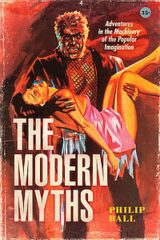The days when (ancient) myths – be they Greek, Nordic or from whatever region – were rather important to man as they served as guidelines and offered counsel are long gone; or so it seems.
 Because popular culture has created books, tales and stories that are inhabited by artificial men, werewolves, vampires, ghost hunters or scientists of a specific sort for the last few hundred years. Their names, status, and special abilities (similar to the superpowers of the even growing number of superhero movies and assorted franchise) are familiar to probably most people in the Western world today.
Because popular culture has created books, tales and stories that are inhabited by artificial men, werewolves, vampires, ghost hunters or scientists of a specific sort for the last few hundred years. Their names, status, and special abilities (similar to the superpowers of the even growing number of superhero movies and assorted franchise) are familiar to probably most people in the Western world today.
In fact, their stories and fates now are the new myths, enjoy the same popularity and have equally become household names, as was the case with old myths, characters, kings or prophets, a development, that put Dracula, Dr. Jekyll and Mr. Hyde, and Sherlock Holmes right there in the action/hero/mythological creature slot reserved for archaic myths in circulation for thousands of years.
But why exactly is that so and what is the purpose of it? Author Philip Ball, who has published several books on the interaction of the sciences and the wider culture, has a theory for that. “In this book, I propose that the Western world has, over the past three centuries or so, produced narratives that have as authentic a claim to mystic status as the psychological dramas of Oedipus, Medea, Narcissus, and Midas and the ancient universal myths of creation, food, redemption, and heroism. …. What is it in these special tales that compels us so compulsively to return to them?”
He argues that this development was triggered by some impulse in the nature of man, or rather, such an impulse decided that an ‘update’ was due. And concludes that the ‘modern’ myth displays and explores some of man’s deepest fears, dreams, and anxieties. As myths once helped to describe, understand and eventually control the world, they still do now, but tell us how to master quite different problems. He argues that myths keep both the idea of the problem and ways of solving it alive. In The Modern Myths: Adventures in the Machinery of the Popular Imagination he devotes seven chapters to those modern replacements and two concluding sections to that theory, where readers are presented with the difficult nature and history of the myth and man’s strange fascination with it.
The examples Ball quotes are topics and characters from popular culture, obviously familiar to most people today: the contemporary myths of Batman, Sherlock Holmes, Dracula, Robinson Crusoe, and Frankenstein, as well as the conclusions from War of the Worlds and Stevenson’s Dr. Jekyll and Mr. Hide. The overall benefit from absorbing their stories (almost exclusively published in the late 19th century) lies in their usefulness for modern man, he suspects. “We create our new myths because they do necessary work. It’s worth getting to know them, and to understand what they are up to.”
The chapters are organized by a long introduction of the respective work, followed by a lot of biographical data on the authors. Ball supports it with many impressions, reviews, quotations and comments from a huge group of critics, literary theorists, and other writers, contemporary and later. All that mass of information is again brought into relation with the popcultural power of the modern myths, in particular how those classic titles with their individual messages informed and still inform the world of fiction today. As several characters (as well as their clones and re-re-re-incarnations) from the classics today populate not just comic books and novels but an almost endless number of movies ranging from horror, to fantasy, science-fiction and action film. Readers can be assured that dozens of blockbuster movies and bestselling novels mentioned here are part of their own popular culture canon and in one way or another have been consumed and collected.
To invent myths in fiction and have them accepted by large audiences, however, is not that easy, as Ball’s musings on almost 400 pages with 60 halftones show. As not every fresh story or tale automatically creates a new myth.”The key to the mythic mode” he explains, “is ambivalence. It’s easy enough to conceive stories where a hero(ine) fights back against fascist robot overlords or tentacled demons. It’s quite another to make those monsters Miltonian – to make us question whether it is the hero we should be cheering on.”
Funny and insightful reading for anybody interested in popular culture and how it has been impacted by the current hunger for myths and their modern incarnations.
Review by Dr. A. Ebert © 2021
Philip Ball. The Modern Myths: Adventures in the Machinery of the Popular Imagination. University of Chicago Press, 2021, 368 p.
